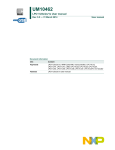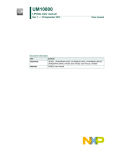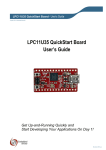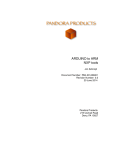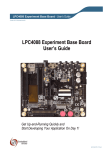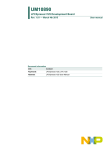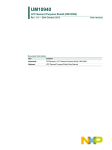Download OM13071 LPCXpresso824-MAX Development board
Transcript
UM10830 OM13071 LPCXpresso824-MAX Development board Rev. 1 — 29 September 2014 User manual Document information Info Content Keywords OM13071, LPC82x, development board, mbed, arduino Abstract This user manual describes the LPCXpresso824-MAX development board. UM10830 NXP Semiconductors OM13071 Revision history Rev Date Description 1 Initial version 20140929 Contact information For more information, please visit: http://www.nxp.com For sales office addresses, please send an email to: [email protected] UM10830 User manual All information provided in this document is subject to legal disclaimers. Rev. 1 — 29 September 2014 © NXP B.V. 2014. All rights reserved. 2 of 11 UM10830 NXP Semiconductors OM13071 1. Introduction The LPCXpresso-MAX family of boards provides a powerful and flexible development system for NXP's low end Cortex-M0+ MCUs. They can be used with a range of development tools, including the LPCXpresso IDE, in addition to ARM's mbed online toolchain. The LPCXpresso824-MAX board is developed by NXP to enable evaluation of and prototyping with the LPC82x family of MCUs. Fig 1 shows the LPCXpresso824-MAX Board. Fig 1. LPCXpresso824-MAX Board 1.1 Features The LPCXpresso824-MAX board includes the following features: • Compatible with LPCXpresso IDE, mbed, and other toolchains. • On-board CMSIS-DAP (debug probe) with USB, based on LPC11U35 MCU. • Debug connector to allow debug of target MCU through an external probe. • Tri-color LED. • Target ISP and WAKE buttons. • Target Reset button. • Target pins available on ‘standard LPCXpresso/mbed’ expansion connector. • Arduino connectors compatible with the “Arduino UNO” platform. • Pmod expansion header. ® UM10830 User manual All information provided in this document is subject to legal disclaimers. Rev. 1 — 29 September 2014 © NXP B.V. 2014. All rights reserved. 3 of 11 UM10830 NXP Semiconductors OM13071 • Prototyping area. • Powering options from multiple sources. • Options to allow measurement of current consumed by target MCU. 2. Board layout The LPCXpresso824-MAX development board layout is shown in Fig 2. Fig 2. UM10830 User manual LPCXpresso824-MAX development board layout All information provided in this document is subject to legal disclaimers. Rev. 1 — 29 September 2014 © NXP B.V. 2014. All rights reserved. 4 of 11 UM10830 NXP Semiconductors OM13071 2.1 Jumper settings Jumpers on the LPCXpresso824-MAX board can be used to configure debug probe selection (on-board vs off-board) or to measure power consumption as described in sections 2.1.1 and 2.1.2. 2.1.1 JP1: on-board/off-board debug When this jumper is open (default), the on-board debug probe (LPC11U35 device) is used as the debug interface. The JP1 header is not fitted during manufacture of the board. The debug probe boots from flash, enumerates as a CMSIS-DAP device, mbed mass storage device, and mbed serial port. See section 5 for more details on the serial port device. When JP1 is closed (jumper fitted), the on-board debug probe is held in reset, and an external debug probe can be connected using the P5 connector. The Reset button can also be held down at board power-up to prevent the LPC11U35 booting up as a CMSIS-DAP debug probe. Note: The mbed serial device will not enumerate when using an external debug probe. 2.1.2 JP2: target current The JP2 jumper is provided to enable supply current to the measuring board by placing an ammeter in line with JP2 pins. By default, the solder jumper (SJ2) bypasses the JP2 jumper. Header P1 can be installed to measure supply power (across a 2.43 ohm resistor on the board). Fig 3 shows a close up of the board in the area where SJ2 and P1 are located. The IC below SJ2 is the LPC824. Fig 3. Close up of board showing SJ2 and P1 See the schematic, available at http://www.lpcware.com/lpcxpresso-max-boards for more information. 2.2 Buttons The LPC824Xpresso-MAX has three push buttons available to control the operation of the LPC824 (target) MCU. Their functions are described in sections 2.2.1, 2.2.2, and 2.2.3. UM10830 User manual All information provided in this document is subject to legal disclaimers. Rev. 1 — 29 September 2014 © NXP B.V. 2014. All rights reserved. 5 of 11 UM10830 NXP Semiconductors OM13071 2.2.1 Reset This button is normally used to reset the LPC824. Holding down this button when the board is powered-up also prevents the LPC11U35 from booting. See section 2.1.1. 2.2.2 ISP The ISP button connects to the LPC824 PIO_12 pin and can be used to force the LPC824 into ISP boot mode. This can be useful when the LPC824 flash is programmed with code that disables the SWD debug pins or changes timing settings so that the debug probe has problems communicating with it. To force ISP boot, hold the ISP button down while pressing and releasing the reset button. The ISP button can also be used to trigger an interrupt by configuring the PIO_12 pin and associated interrupt controls within your application code. 2.2.3 Wake Depressing this button triggers a wake interrupt by pulling-down the WAKEUP input (pin 4) of the LPC824. 2.3 LEDs There are five LED devices on the board: one tricolor device (with red, green, and blue channels) for user programs, three discrete LEDs that indicate the activity of the debug probe, and a power LED. The Tricolor LED is driven by PIO_12 (red), PIO_16 (green) and PIO_27 (blue), with the LEDs illuminating when those lines are driven low. Note: The red tricolor LED channel is also controlled by PIO_12, so the tricolor LED turns red when ISP is depressed. The status LEDs operate as follows: • USB Disk LED (red): illuminates when the mbed disk device is being accessed. • CMSIS-DAP (green): illuminates when debug activity (control of the target SWD port) is occurring. • USB Comm (blue): illuminates when the mbed serial port device is active. 3. Expansion connectors The LPCXpresso824-MAX board provides four options for expanding the capabilities of the board by adding hardware to it: • Arduino UNO style headers. • LPCXpresso/mbed headers. • Pmod header. • Prototyping area. UM10830 User manual All information provided in this document is subject to legal disclaimers. Rev. 1 — 29 September 2014 © NXP B.V. 2014. All rights reserved. 6 of 11 UM10830 NXP Semiconductors OM13071 See the board schematics, available at http://www.lpcware.com/lpcxpresso-max-boards, for more information. 3.1 Arduino UNO headers Arduino is a popular hobbyist platform, with a standardized set of expansion connectors. The Arduino connectors on the LPCXpresso824-MAX board are compatible with the “Arduino UNO” platform. Several compatible expansion cards (shields) can be obtained from vendors such as Sparkfun, Adafruit, and others. Shield designs might vary in their implementation because the Arduino UNO platform is based on guidelines and is not a fully defined specification. See the LPCXpresso824-MAX schematics and those of the board(s) you are interfacing before attempting to connect the two together. The Arduino UNO headers are factory installed on the LPCXpresso824-MAX. 3.2 LPCXpresso™ / mbed headers The LPCXpresso headers on the LPCXpresso824-MAX are suitable for use with existing LPCXpresso compatible baseboards, available from 3rd parties such as Embedded Artists. Check the component clearance on any baseboard you are considering to ensure components on the baseboard will not interfere with the mounting of the LPCXpresso824-MAX because this board is wider than the original mbed and LPCXpresso™ boards. LPCXpresso expansion headers can be mounted on the bottom side of the PCB but are not factory fitted. 3.3 Pmod™ header Pmod support is available on the LPCXpresso824-MAX: • Pins 1 – 6 (left side) will support Pmod™ Type 2 (SPI) or Type 1 (GPIO). • Pins 7 – 12 (right side) design to support I C. Will Pmod™ Type 1 (GPIO) interface. 2 Mount the Pmod connectors on the top side of the PCB. Note: Connectors are not factory fitted for this interface. 4. Using development tools 4.1 LPCXpresso IDE LPCXpresso IDE supports programming and debugging LPCXpresso-MAX boards using the on-board CMSIS-DAP debug interface, or with an external debug probe, such as LPC-Link2. Version 7.4 or later of the LPCXpresso IDE is required. Download the IDE from: http://www.lpcware.com/lpcxpresso. 4.1.1 Debugging via the built-in debug probe LPCXpresso824-MAX is pre-programmed with CMSIS-DAP/mbed firmware and will work out of the box with the LPCXpresso IDE. The IDE can detect the board as a CMSIS-DAP probe when it is used for the first time and asks for confirmation that this is the correct target. For subsequent debug sessions, this target selection is made automatically. UM10830 User manual All information provided in this document is subject to legal disclaimers. Rev. 1 — 29 September 2014 © NXP B.V. 2014. All rights reserved. 7 of 11 UM10830 NXP Semiconductors OM13071 If running on Windows, you will need to install the mbed Windows serial port driver so that the LPCXpresso824-MAX board’s CMSIS-DAP debug link is visible to LPCXpresso. Download the drivers from: http://mbed.org/handbook/Windows-serial-configuration#1-download-the-mbed-windowsserial-port 4.1.2 Debugging with an external debug probe JP1 should be closed (jumper fitted) to use the board with an external debug probe. See section 2.1.1 for more information. 4.2 mbed The LPCXpresso824-MAX board implements the latest version of the mbed interface from ARM. When connected to a PC, the board enumerates as a mass-storage device. Firmware images placed on it are written to the target MCU after a power cycle, per other mbed boards. See http://www.mbed.org/teams/NXP for more information on downloading the mbed SDK for the board and the mbed development environment. 4.3 Using other toolchains A number of other toolchains can be used since the LPCXpresso-MAX boards support the CMSIS-DAP protocol. Refer to the manuals from your development toolchain provider for more information on how to use CMSIS-DAP probes. 5. Example code and drivers The LPCOpen platform allows users to quickly and easily utilize NXP's extensive array of microcontroller software libraries to create and develop multifunctional products. The platform uses common APIs that work equally across all microcontroller families and can be built with Keil, IAR, and LPCXpresso toolchains. Detailed documentation and examples make it easy to integrate the necessary development tools into projects. For more information on LPCOpen, go to http://www.lpcware.com/lpcopen. For direct access to the LPCOpen drivers for the LPCXpresso824-MAX board, go to: http://www.lpcware.com/lpcxpresso-max-boards. The LPCXpresso824-MAX enumerates an mbed serial port device when installed. This serial port is bridged from a LPC824 UART by the LPC11U35 to its USB port and is used by the mbed tools. This device can also be used by host computer applications (such as Tera Term) for debugging and application purposes when developing with other toolchains. Some of the UART examples in LPCOpen show you how to use this port (example, periph_mrt). However, other examples might use a different UART on the LPC824 that require external circuitry or cables to be connected using the expansion connectors. 6. Re-flashing the debug probe (LPC11U3x) The debug probe (LPC11U3x MCU) on the LPCXpresso824-MAX is programmed during manufacture and does not require any update. However, if a firmware update is required, follow these steps to re-program the flash: 1. Unplug the usb connector. 2. Hold down the reset button and plug in the usb connector. UM10830 User manual All information provided in this document is subject to legal disclaimers. Rev. 1 — 29 September 2014 © NXP B.V. 2014. All rights reserved. 8 of 11 UM10830 NXP Semiconductors OM13071 3. 4. 5. 6. The board will appear on your system as a disk called CRP DISABLD. Delete the file called firmware.bin on this disk. Drag and drop the new binary image to be programmed onto this disk. Connect and re-connect usb. 7. Board specifications o Recommended operating conditions: 0 to 70 C ambient temperature Weight: 0.7 ounces Size: 2.15 x 3.05 inches The LPCXpresso824-MAX board is RoHS compliant. UM10830 User manual All information provided in this document is subject to legal disclaimers. Rev. 1 — 29 September 2014 © NXP B.V. 2014. All rights reserved. 9 of 11 UM10830 NXP Semiconductors OM13071 8. Legal information 8.1 Definitions Draft — The document is a draft version only. The content is still under internal review and subject to formal approval, which may result in modifications or additions. NXP Semiconductors does not give any representations or warranties as to the accuracy or completeness of information included herein and shall have no liability for the consequences of use of such information. 8.2 Disclaimers Limited warranty and liability — Information in this document is believed to be accurate and reliable. However, NXP Semiconductors does not give any representations or warranties, expressed or implied, as to the accuracy or completeness of such information and shall have no liability for the consequences of use of such information. In no event shall NXP Semiconductors be liable for any indirect, incidental, punitive, special or consequential damages (including - without limitation lost profits, lost savings, business interruption, costs related to the removal or replacement of any products or rework charges) whether or not such damages are based on tort (including negligence), warranty, breach of contract or any other legal theory. Notwithstanding any damages that customer might incur for any reason whatsoever, NXP Semiconductors’ aggregate and cumulative liability towards customer for the products described herein shall be limited in accordance with the Terms and conditions of commercial sale of NXP Semiconductors. Right to make changes — NXP Semiconductors reserves the right to make changes to information published in this document, including without limitation specifications and product descriptions, at any time and without notice. This document supersedes and replaces all information supplied prior to the publication hereof. UM10830 User manual Suitability for use — NXP Semiconductors products are not designed, authorized or warranted to be suitable for use in life support, life-critical or safety-critical systems or equipment, nor in applications where failure or malfunction of an NXP Semiconductors product can reasonably be expected to result in personal injury, death or severe property or environmental damage. NXP Semiconductors accepts no liability for inclusion and/or use of NXP Semiconductors products in such equipment or applications and therefore such inclusion and/or use is at the customer’s own risk. Applications — Applications that are described herein for any of these products are for illustrative purposes only. NXP Semiconductors makes no representation or warranty that such applications will be suitable for the specified use without further testing or modification. Customers are responsible for the design and operation of their applications and products using NXP Semiconductors products, and NXP Semiconductors accepts no liability for any assistance with applications or customer product design. It is customer’s sole responsibility to determine whether the NXP Semiconductors product is suitable and fit for the customer’s applications and products planned, as well as for the planned application and use of customer’s third party customer(s). Customers should provide appropriate design and operating safeguards to minimize the risks associated with their applications and products. NXP Semiconductors does not accept any liability related to any default, damage, costs or problem which is based on any weakness or default in the customer’s applications or products, or the application or use by customer’s third party customer(s). Customer is responsible for doing all necessary testing for the customer’s applications and products using NXP Semiconductors products in order to avoid a default of the applications and the products or of the application or use by customer’s third party customer(s). NXP does not accept any liability in this respect. Export control — This document as well as the item(s) described herein may be subject to export control regulations. Export might require a prior authorization from competent authorities. All information provided in this document is subject to legal disclaimers. Rev. 1 — 29 September 2014 © NXP B.V. 2014. All rights reserved. 10 of 11 UM10830 NXP Semiconductors OM13071 9. Contents 1. 2. 2.1 2.1.1 2.1.2 2.2 2.2.1 2.2.2 2.2.3 2.3 3. 3.1 3.2 3.3 4. 4.1 4.1.1 4.1.2 4.2 4.3 5. 6. 7. 8. 8.1 8.2 9. Introduction ......................................................... 3 Board layout ........................................................ 4 Jumper settings .................................................. 5 JP1: on-board/off-board debug .......................... 5 JP2: target current.............................................. 5 Buttons ............................................................... 5 Reset.................................................................. 6 ISP ..................................................................... 6 Wake .................................................................. 6 LEDs .................................................................. 6 Expansion connectors ........................................ 6 Arduino UNO headers ........................................ 7 LPCXpresso™ / mbed headers.......................... 7 Pmod™ header .................................................. 7 Using development tools .................................... 7 LPCXpresso IDE ................................................ 7 Debugging via the built-in debug probe .............. 7 Debugging with an external debug probe........... 8 mbed .................................................................. 8 Using other toolchains ........................................ 8 Example code and drivers .................................. 8 Re-flashing the debug probe (LPC11U3x) ......... 8 Board specifications ........................................... 9 Legal information .............................................. 10 Definitions ........................................................ 10 Disclaimers....................................................... 10 Contents ............................................................. 11 Please be aware that important notices concerning this document and the product(s) described herein, have been included in the section 'Legal information'. © NXP B.V. 2014. All rights reserved. For more information, please visit: http://www.nxp.com For sales office addresses, please send an email to: [email protected] Date of release: 29 September 2014 Document identifier: UM10830











